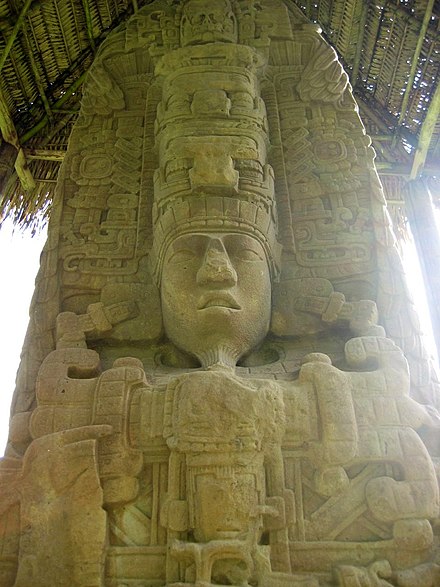Kʼakʼ Tiliw Chan Yopaat
| Kʼakʼ Tiliw Chan Yopaat | |
|---|---|
| Ajaw | |
 Stela D, north side, from Quiriguá, representing king Kʼakʼ Tiliw Chan Yopaat.[1] | |
| King of Quiriguá | |
| Reign | 29 December 724 - 27 July 785 |
| Predecessor | Unknown (Last known ruler: K'awiil Yopaat) |
| Successor | Sky Xul |
| Born | c.690[2] Quiriguá |
| Died | 31 July 785 (aged 94–95) Quiriguá |
| Issue | Sky Xul (possibly) |
| Religion | Maya religion |
Kʼakʼ Tiliw Chan Yopaat,[pronunciation?] previously known variously as Cauac Sky,[3] Kawak Sky, Butsʼ Tiliw[pronunciation?] and Butzʼ Tiʼliw, was the greatest leader of the ancient Maya city-state of Quiriguá.
Reign
Kʼakʼ Tiliw Chan Yopaat ruled the city from 724 to 785 AD. The most significant event of his reign—and of Quiriguá's history—occurred in AD 738 (9.15.6.14.6 on the Mayan calendar), when his forces defeated the city of Copán. The ruler of Copán, Uaxaclajuun Ubʼaah Kʼawiil (formerly known as "18 Rabbit") was captured and later beheaded.[4]
Before Kʼakʼ Tiliw Chan Yopaat's bold move, Quiriguá had been a vassal of Copán.[5] The defeat of Copán led to its decline but heralded a golden age for its former dependent. For the next 38 years, stonecutters of Quiriguá created zoomorphs and stelae celebrating their legendary king. Quiriguá became a fully autonomous city which controlled the main trade route from the Caribbean to the Maya world. Meanwhile, this incident was followed by a 20-year hiatus in inscriptions at Copán, as well as the disappearance of any further mention of 18 Rabbit.
Current evidence leads to the conclusion that Kʼakʼ Tiliw Chan Yopaat died in 785 AD. There remains a stone at Quiriguá, now identified as Zoomorph G, which seems to have served as his funeral marker.[6]
Two other rulers are known to have reigned at Quiriguá in ensuing years—Sky Xul and Jade Sky—each for about ten years.[7] But none reached the heights achieved by their predecessor.
Notes
References
- Drew, David (1999). The Lost Chronicles of the Maya Kings. London: Weidenfeld & Nicolson. ISBN 0-297-81699-3. OCLC 43401096.
- Looper, Matthew G. (1999). "New Perspectives on the Late Classic Political History of Quirigua, Guatemala". Ancient Mesoamerica. 10 (2). Cambridge University Press: 263–280. doi:10.1017/s0956536199101135.
- Looper, Matthew G. (2003). Lightning Warrior: Maya Art and Kingship at Quirigua. Austin, TX: University of Texas Press. ISBN 0-292-70556-5. OCLC 52208614.
- Velásquez García, Erik (2006). "Iconografía real de Kʼahkʼ Tiliw Chan Yoʼaat: política y fundación del mundo en Quiriguá, Guatemala". In Cuauhtémoc Medina (ed.). La imagen política: XXV Coloquio Internacional de Historia del Arte "Francisco de la Maza" [2001, San Luis Potosí, México]. Estudios de arte y estética, no. 60 (in Spanish). México, D.F.: Instituto de Investigaciones Estéticas-Universidad Nacional Autónoma de México. pp. 113–146. ISBN 978-970-32-1883-7. OCLC 219717969.
- Martin, Simon; Nikolai Grube (2000). Chronicle of the Maya Kings and Queens: Deciphering the Dynasties of the Ancient Maya. London and New York: Thames & Hudson. ISBN 0-500-05103-8. OCLC 47358325.
- Webster, David L. (2002). The Fall of the Ancient Maya: Solving the Mystery of the Maya Collapse. London: Thames & Hudson. ISBN 0-500-05113-5. OCLC 48753878.
